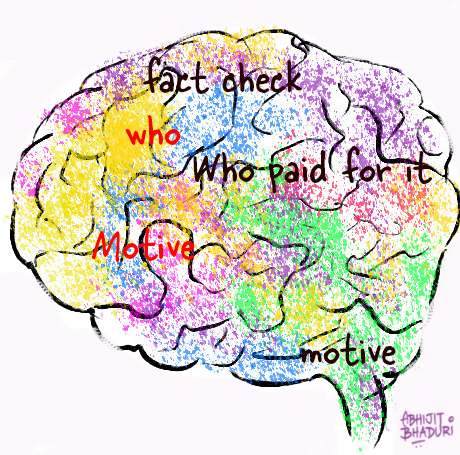Algorithms cannot #breakthebias - humans can
Hiring decisions, promotions, rewards... biases is an invisible enemy. We have to #breakthebias if workplaces aim to be inclusive.
Career paths have a strong element of bias
If you want to identify some of your biases and prejudices, try completing these sentences with the first thought that comes to your mind.
It is hard for people above a certain age to ...
The millennials cannot ...
Engineers are not good at ...
Women are not good at roles in ...
If we think of a tabla player most people think of a man playing the tabla. We rarely think of a female bus conductor. Gender is not the only bias that prevents people from thriving in a profession. It is a very big part of the talent crunch we are facing now.
<read about women who are breaking the bias>
Bias is a shortcut that is misleading
Make it stand out
Why do we get biased for or against an idea? We are flooded with information, opinions, facts and false hoods multiple times every day. Emails and WhatsApp forwards and mindless retweets are feeding us unchecked facts. "Experts" spring up overnight to offer theories that support a certain ideology.
Facts, inferences and opinions are all put in a blender and served to us. Separating them is exhausting. Biases are thumb rules we create based on inferences and opinions.
Biases are the invisible barriers we stumble upon
Make it stand out
Nowhere does the barrier of bias show up more than the process of hiring.
It all starts with the resume
The hiring manager spends less than six seconds to screen a resume. This is where biases cloud human judgement.
Indian names can tell you the caste, languages you speak and in some cases even the socio-economic status of the applicant. The gender of the applicant can be guessed easily from the name in the resume. Many jobs in sales or manufacturing plants do not shortlist women. Their applicants are rejected because of bias and prejudice.
While many people speak about using algorithms to screen resumes, that does not solve the problem of bias and prejudice. Read on.
<read: why should hiring be driven by a resume?>
Ranking colleges creates a caste system
While educational qualifications are no predictor of employability, when the employers rank colleges into "premier" or "Tier 1/ Tier 2", their biases come through. This creates an invisible caste system that is unfair. This bias assumes people who go to the top ranked colleges are better than those who have not. When the leadership of the <read: The case for unbranded talent>
Then there is the problem of degree inflation. People don't want someone who knows more than what the job demands. When the economy has an oversupply of talent, degree inflation creates its own invisible barrier. <read more>
Experience is like temperature - too little or too much
Most job seekers find that when they start job hunting they fall into one of the two categories - too little experience or too much of it. Young people do not have enough experience to get the job. The older people have too much of it and hence not given a chance.
Women often discover that taking a break to raise a family throws them off the job market for years. Years of experience gets ignored by potential employers.
'We don't hire women in Sales'
Some jobs in Manufacturing and Sales have seen fewer women. This is again based on the assumptions around what can and cannot do. Unilever's action to have a workforce of women from rural areas is proof that bias against women in sales is misplaced. <read this>
“We have empowered more than 70,000 women in rural India to become an extended part of Unilever’s salesforce, selling home-to-home to consumers and also in and around the village. These women not only now earn income to support the families but have significantly enhanced self-esteem and self-worth.”
'Appearance' bias
Hiring managers are hesitant to hire conventionally beautiful people for less desirable jobs such as warehouse worker, housekeeper and customer service representative. <read this>
Research shows that a visible disability can limit the career opportunities because it triggers some bias implicitly. Other things being equal, a person with disability will find it harder to get hired. The bias people have toward people with disabilities, is known as 'ableism,' over time it only gets more reinforced. <read this>
It is hard enough for women to get hired in some jobs. Some careers are frowned upon as choices for women. Some firms do not wish to hire them. Even fewer firms invest in coaching and mentoring the women leaders.
What are some firms doing
Mastek - an IT services firm has been creating spaces for conversations on various themes to break the bias. Topics range from women in technology, how to debunk gender role stereotypes, building gender equality in tech, how to work with mentors to build safe spaces for people to talk about bias and stereotypes. Ms Preethi Rao, Mastek Board Member and Global CHRO Maninder Kapoor Puri and other women leaders across the globe, share their own stories and insights on a broad range of topics around bias as well.
When the leaders build the psychological safety that helps people speak openly unconscious biases can be identified.
#breakthebias Start Here
Check out this sample quiz to determine the biases you are not even aware of. I took this and found it powerful
"Biases tend to affect who gets hired, who gets promoted, who gets raises and who gets what kind of work, among other things. By knowing where bias is most likely to creep in, you can take steps to ensure that biases are considered when important decisions are made in those areas." <read more>
Using algorithms is not enough
Imagine if the algorithm threw up a woman candidate as the head of Sales for your organisation. The new hire's success or failure will be determined by the support she receives from the colleagues, the leadership team and the culture of the organisation. These are all human factors. Breaking the bias begins with humans not algorithms.






